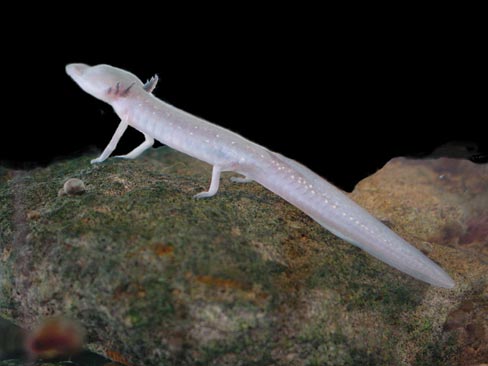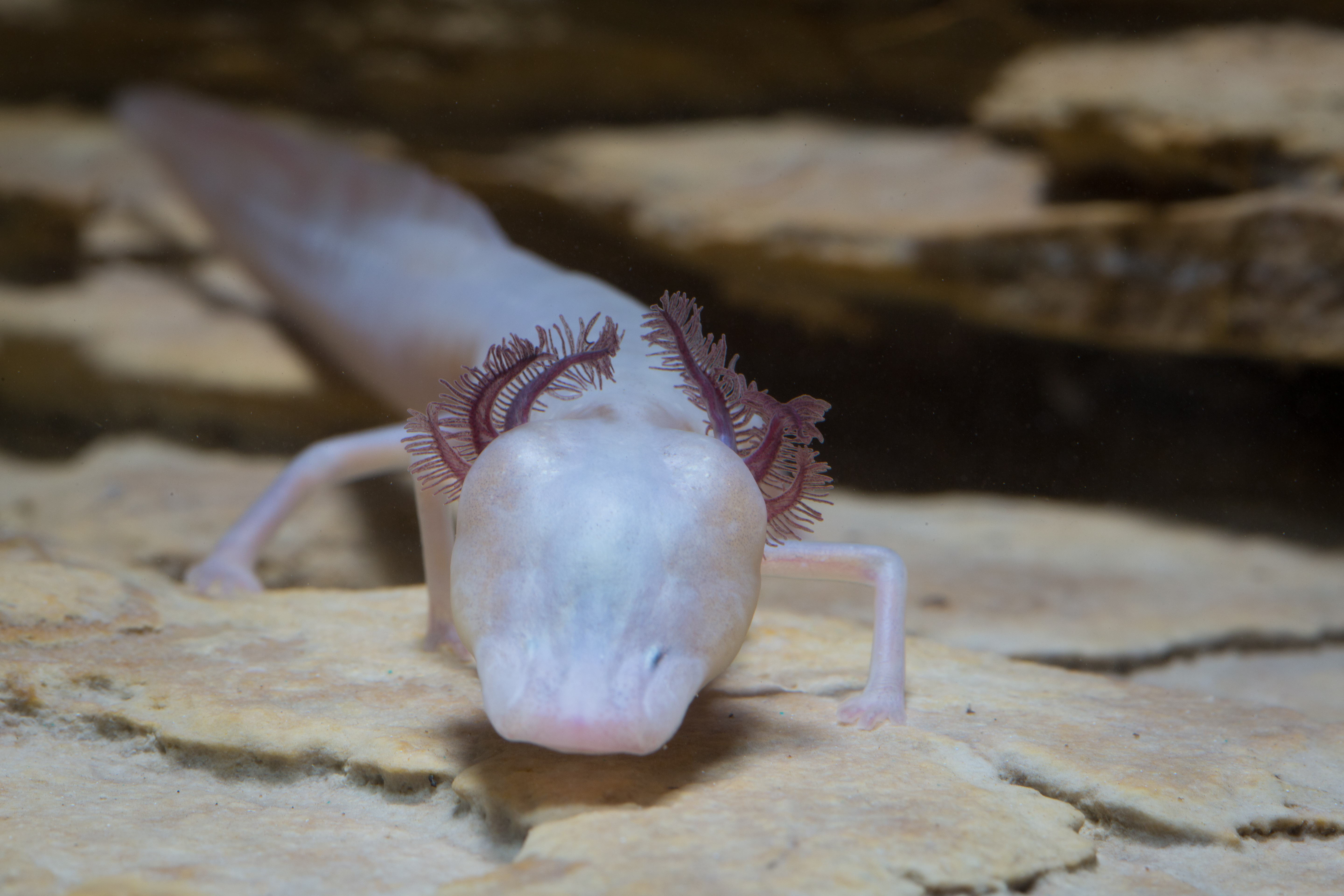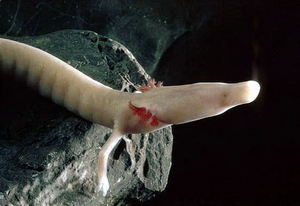|
Troglomorphism
Troglomorphism is the morphological adaptation of an animal to living in the constant darkness of caves, characterised by features such as loss of pigment, reduced eyesight or blindness, and frequently with attenuated bodies and/or appendages. The terms troglobitic, stygobitic, stygofauna, troglofauna, and hypogean or hypogeic, are often used for cave-dwelling organisms. A 2012 study by a team from the National University of Singapore found that reductive changes in freshwater cave crabs evolved at the same rate as constructive changes. This shows that both selection and evolution have a role in advancing reductive changes (e.g smaller eyes) and constructive changes (e.g larger claws), making troglomorphic adaptations subject to strong factors that affect an organism's morphology. Troglomorphism occurs in molluscs, velvet worms, arachnids, myriapods, crustaceans, insects, fish, amphibians (notably cave salamanders) and reptiles. To date no mammals or birds have been found to live ... [...More Info...] [...Related Items...] OR: [Wikipedia] [Google] [Baidu] |
Cavefish
Cavefish or cave fish is a generic term for fresh and brackish water fish adapted to life in caves and other underground habitats. Related terms are subterranean fish, troglomorphic fish, troglobitic fish, stygobitic fish, phreatic fish and hypogean fish.Romero, Aldemaro, editor (2001). ''The Biology of Hypogean Fishes.'' Developments in Environmental Biology of Fishes. Helfman, G.S. (2007). ''Fish Conservation: A Guide to Understanding and Restoring Global Aquatic Biodiversity and Fishery Resources'', pp. 41–42. Island Press. There are more than 200 scientifically described species of obligate cavefish found on all continents, except Antarctica. Although widespread as a group, many cavefish species have very small ranges and are seriously threatened.Fenolio, D.B.; Zhao, Y.; Niemiller, M.L.; and Stout, J. (2013). ''In-situ observations of seven enigmatic cave loaches and one cave barbel from Guangxi, China, with notes on conservation status.'' Speleobiology Notes 5: 19-33. ... [...More Info...] [...Related Items...] OR: [Wikipedia] [Google] [Baidu] |
Texas Blind Salamander
The Texas blind salamander (''Eurycea rathbuni'') is a rare cave-dwelling troglobite amphibian native to San Marcos, Hays County, Texas, specifically the San Marcos Pool of the Edwards Aquifer. Description The species has a broad, flat, snout and head, and vestigial eyes beneath that are covered by skin. Like other neotenous salamanders, it has external gills for absorbing oxygen from the water. The salamander's mature length is around . The forelimbs carry four digits and the hind limbs possess five digits. Its diet varies by what flows into its cave, and includes blind shrimp (''Palaemonetes antrorum''), snails, and amphipods. Distribution and habitat Specimens have been collected at seven localities in the Purgatory Creek system and along the San Marcos Fault near San Marcos, Texas. Adults and immature larvae are well-adapted for living in underground streams in caves, and many probably inhabit deep recesses that are not accessible to collectors. Specimens have been ta ... [...More Info...] [...Related Items...] OR: [Wikipedia] [Google] [Baidu] |
Arachnid
Arachnida () is a class of joint-legged invertebrate animals ( arthropods), in the subphylum Chelicerata. Arachnida includes, among others, spiders, scorpions, ticks, mites, pseudoscorpions, harvestmen, camel spiders, whip spiders and vinegaroons. Almost all adult arachnids have eight legs, although the front pair of legs in some species has converted to a sensory function, while in other species, different appendages can grow large enough to take on the appearance of extra pairs of legs. The term is derived from the Greek word (''aráchnē'', 'spider'), from the myth of the hubristic human weaver Arachne, who was turned into a spider. Almost all extant arachnids are terrestrial, living mainly on land. However, some inhabit freshwater environments and, with the exception of the pelagic zone, marine environments as well. They comprise over 100,000 named species, of which 47,000 are species of spiders. Morphology Almost all adult arachnids have eight legs, unli ... [...More Info...] [...Related Items...] OR: [Wikipedia] [Google] [Baidu] |
List Of Troglobites
A troglobite (or, formally, troglobiont) is an animal species, or population of a species, strictly bound to underground habitats, such as caves. These are separate from species that mainly live in above-ground habitats but are also able to live underground (eutroglophiles), and species that are only cave visitors (subtroglophiles and trogloxenes). Land-dwelling troglobites may be referred to as troglofauna, while aquatic species may be called stygofauna, although for these animals the term ''stygobite'' is preferable. Troglobites typically have evolutionary adaptations to cave life. Examples of such adaptations include slow metabolism, reduced energy consumption, better food usage efficiency, decrease or loss of eyesight (anophthalmia), and depigmentation (absence of pigment in the integument). Conversely, as opposed to lost or reduced functions, many species have evolved elongated antenna and locomotory appendages, in order to better move around and respond to environmenta ... [...More Info...] [...Related Items...] OR: [Wikipedia] [Google] [Baidu] |
Troglophile
Troglofauna are small cave-dwelling animals that have adapted to their dark surroundings. Troglofauna and stygofauna are the two types of subterranean fauna (based on life-history). Both are associated with subterranean environments – troglofauna are associated with caves and spaces above the water table and stygofauna with water. Troglofaunal species include spiders, insects, myriapods and others. Some troglofauna live permanently underground and cannot survive outside the cave environment. Troglofauna adaptations and characteristics include a heightened sense of hearing, touch and smell. Loss of under-used senses is apparent in the lack of pigmentation as well as eyesight in most troglofauna. Troglofauna insects may exhibit a lack of wings and longer appendages. Ecological categories Troglofauna are divided into three main categories based on their ecology: * Troglobionts (or troglobites): species, or populations of species, strictly bound to subterranean habitats. * Trogloph ... [...More Info...] [...Related Items...] OR: [Wikipedia] [Google] [Baidu] |
Trogloxene
Trogloxenes or subtroglophiles, also called cave guests, are animal species which periodically live in underground habitats such as caves or at the very entrance, but cannot live exclusively in such habitats."Cave Plants and Animals". 9 December Among many scientists, trogloxenes and subtroglophile have slightly different but closely related meanings, with the former covering species that are occasional visitors to underground habitat and the latter species that live more permanently there, but have to go outside (for example, to find food). Both these are in contrast to troglobites, which strictly live in underground habitats. Examples of trogloxene/subtroglophile species are bats, rats, raccoons and some opiliones (this last group also has fully troglobitic species). Several extinct trogloxenes are known like cave bears, cave lions, cave leopards, and cave hyenas. Indications trusted by geologists and archaeologists combine to show that these animals lived there in the latter pa ... [...More Info...] [...Related Items...] OR: [Wikipedia] [Google] [Baidu] |
Pickerel Frog
The pickerel frog (''Lithobates palustris'', formerly ''Rana palustris'') is a small North American frog, characterized by the appearance of seemingly "hand-drawn" squares on its dorsal surface. Distinguishing features The pickerel frog is a medium sized gray or tan frog marked with seven to twenty-one irregular rectangular dark brown spots which are oriented in two columns down its back.Who is the Pickerel Frog. http://people.wcsu.edu/ The distinctive rectangular spots of the pickerel frog may blend together to form a long rectangle along the back. All leopard frogs have circular spots. In addition, pickerel frogs have prominent dorsolateral ridges that are unbroken. Another important distinguishing mark is the orange or yellow flash pattern found on the inner surface of the hind legs of pickerel frogs. The frog must be picked up to examine this, as the legs cover the coloration otherwise. The plains leopard frog (''Lithobates blairi'') exhibits this coloration as well, but th ... [...More Info...] [...Related Items...] OR: [Wikipedia] [Google] [Baidu] |
Cave Salamander
A cave salamander is a type of salamander that primarily or exclusively inhabits caves, a group that includes several species. Some of these animals have developed special, even extreme, adaptations to their subterranean environments. Some species have only rudimentary (or even absent) eyes (''blind salamanders''). Others lack pigmentation, rendering them a pale yellowish or pinkish color (e.g., '' Eurycea rathbuni''). With the notable exception of '' Proteus anguinus'', all "cave salamanders" are members of the family Plethodontidae ("lungless salamanders"). History The first dedicated scientific study of a cave animal was focused upon a cave salamander, '' Proteus anguinus''. It was originally identified as a "dragon's larva" by Johann Weikhard von Valvasor in 1689. Later, the Austrian naturalist Joseph Nicolaus Lorenz described it scientifically in 1768. Another early scientific description of a cave salamander was undertaken by Constantine Samuel Rafinesque in 1822 while h ... [...More Info...] [...Related Items...] OR: [Wikipedia] [Google] [Baidu] |
Myriapods
Myriapods () are the members of subphylum Myriapoda, containing arthropods such as millipedes and centipedes. The group contains about 13,000 species, all of them terrestrial. The fossil record of myriapods reaches back into the late Silurian, although molecular evidence suggests a diversification in the Cambrian Period, and Cambrian fossils exist which resemble myriapods. The oldest unequivocal myriapod fossil is of the millipede '' Pneumodesmus newmani'', from the late Silurian (428 million years ago). ''P. newmani'' is also important as the earliest known terrestrial animal. The phylogenetic classification of myriapods is still debated. The scientific study of myriapods is myriapodology, and those who study myriapods are myriapodologists. Anatomy Myriapods have a single pair of antennae and, in most cases, simple eyes. Exceptions are the two classes symphylans and pauropods, and the millipede order Polydesmida and the centipede order Geophilomorpha, which are all ey ... [...More Info...] [...Related Items...] OR: [Wikipedia] [Google] [Baidu] |
Velvet Worm
Onychophora (from grc, ονυχής, , "claws"; and , , "to carry"), commonly known as velvet worms (due to their velvety texture and somewhat wormlike appearance) or more ambiguously as peripatus (after the first described genus, ''Peripatus''), is a phylum of elongate, soft-bodied, many-legged panarthropods. In appearance they have variously been compared to worms with legs, caterpillars, and slugs. They prey upon other invertebrates, which they catch by ejecting an adhesive slime. Approximately 200 species of velvet worms have been described, although the true number of species is likely greater. The two extant families of velvet worms are Peripatidae and Peripatopsidae. They show a peculiar distribution, with the peripatids being predominantly equatorial and tropical, while the peripatopsids are all found south of the equator. It is the only phylum within Animalia that is wholly endemic to terrestrial environments, at least among extant members. Velvet worms are generally ... [...More Info...] [...Related Items...] OR: [Wikipedia] [Google] [Baidu] |
Morphology (biology)
Morphology is a branch of biology dealing with the study of the form and structure of organisms and their specific structural features. This includes aspects of the outward appearance ( shape, structure, colour, pattern, size), i.e. external morphology (or eidonomy), as well as the form and structure of the internal parts like bones and organs, i.e. internal morphology (or anatomy). This is in contrast to physiology, which deals primarily with function. Morphology is a branch of life science dealing with the study of gross structure of an organism or taxon and its component parts. History The etymology of the word "morphology" is from the Ancient Greek (), meaning "form", and (), meaning "word, study, research". While the concept of form in biology, opposed to function, dates back to Aristotle (see Aristotle's biology), the field of morphology was developed by Johann Wolfgang von Goethe (1790) and independently by the German anatomist and physiologist Karl Fr ... [...More Info...] [...Related Items...] OR: [Wikipedia] [Google] [Baidu] |
Evolution
Evolution is change in the heritable characteristics of biological populations over successive generations. These characteristics are the expressions of genes, which are passed on from parent to offspring during reproduction. Variation tends to exist within any given population as a result of genetic mutation and recombination. Evolution occurs when evolutionary processes such as natural selection (including sexual selection) and genetic drift act on this variation, resulting in certain characteristics becoming more common or more rare within a population. The evolutionary pressures that determine whether a characteristic is common or rare within a population constantly change, resulting in a change in heritable characteristics arising over successive generations. It is this process of evolution that has given rise to biodiversity at every level of biological organisation, including the levels of species, individual organisms, and molecules. The theory of evol ... [...More Info...] [...Related Items...] OR: [Wikipedia] [Google] [Baidu] |









